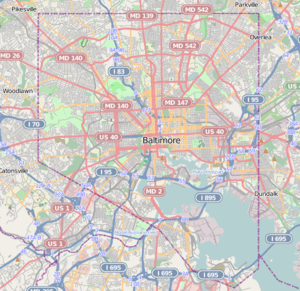Mount Auburn Cemetery (Baltimore, Maryland)
Mount Auburn Cemetery is a historic African American cemetery and national historic district in Baltimore, Maryland, United States.[2] Overlooking the Middle Branch of the Patapsco River to the east, Baltimore's Downtown to the north and railroad tracks to the south, Mt. Auburn Cemetery is surrounded by the Cherry Hill, Westport, Mt. Winans and Lakeland communities.[3]
Mount Auburn Cemetery | |
Mount Auburn Cemetery, December 2011 | |
 | |
| Location | 2614 Annapolis Rd., Baltimore, Maryland |
|---|---|
| Coordinates | 39°15′34″N 76°38′23″W |
| Area | 34 acres (14 ha) |
| Built | 1872 |
| Architect | Pinkney, Roland Sr. |
| Architectural style | Gothic, Classical Revival, et al. |
| NRHP reference No. | 01000456[1] |
| Added to NRHP | September 7, 2001 |
History
One of the most historic and largest African American cemeteries in Baltimore, Mt. Auburn Cemetery was formed in 1872, by the Reverend James Peck in protest to segregation against the White Methodist Church. Its grounds encompass 34 acres (140,000 m2) and holds more than 55,000 interred.[3]
Designated on the local and national historic registers, the cemetery was once known as "The City of the Dead for Colored People" since it was the only place a person of color could be buried. Once part of a farm, the land was given to the Methodist Church and assigned to the Sharp Street Memorial United Methodist Church to oversee its grounds.[3] Over the years the cemetery has been in total neglect with only a few of its front acreage remaining identifiable as a cemetery.
Mt. Auburn Cemetery holds the remains of some of Baltimore's and the nation's "movers and shakers" of the local civil rights movement. In addition to runaway slaves, the cemetery contains the remains of the first African American ship chandler; clergymen; the first female funeral home director, Civil War and civil rights activists, lawyers, doctors, teachers, military veterans, founders of national fraternities’ and sororities’ and the ancestors of thousands of African-American families.
Mount Auburn Cemetery was added to the National Register of Historic Places in 2001.[1]
Notable interments
- Joe Gans (1874-1910), first African American lightweight boxing champion of the world (1901-1908).
- William Ashbie Hawkins (1862-1941), early African American bishop in the African Methodist Church, and one of Baltimore's first African American lawyers.
- Lillie Mae Carroll Jackson (1889-1975), pioneering civil rights activist who brought the National Association for the Advancement of Colored People to Baltimore and was its leader for 35 years.
References
- "National Register Information System". National Register of Historic Places. National Park Service. July 9, 2010.
- U.S. Geological Survey Geographic Names Information System: Mount Auburn Cemetery (Baltimore, Maryland)
- Dorothy M. Dougherty (March 2001). "National Register of Historic Places Registration: Mount Auburn Cemetery" (PDF). Maryland Historical Trust. Retrieved 2016-04-01.
External links
| Wikimedia Commons has media related to Mount Auburn Cemetery (Baltimore, Maryland). |
- Mount Auburn Cemetery, Baltimore City, including photo dated 1997, at Maryland Historical Trust
- The Historical Marker Database, Mount Auburn Cemetery Marker
- "Mobtown Beat: The Plot Sickens, Mount Auburn Cemetery Is Still In Shambles," By Jason Torres, Baltimore City Paper, Posted May 30, 2007.
- Historic images of Mt. Auburn cemetery from the Afro-American newspaper
- Why Are Black & White Funeral Homes STILL Separate? documentary short recorded at Mount Auburn Cemetery (2020)

